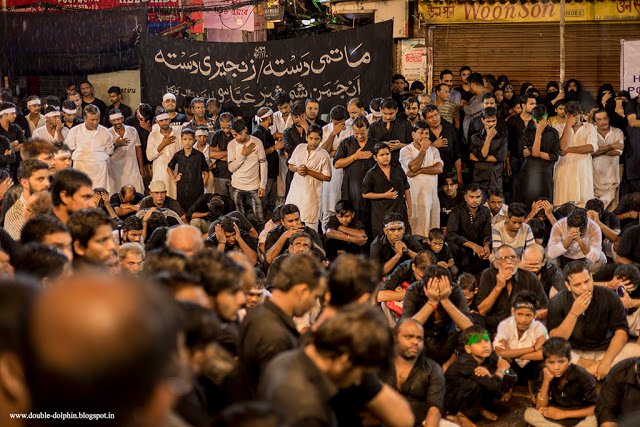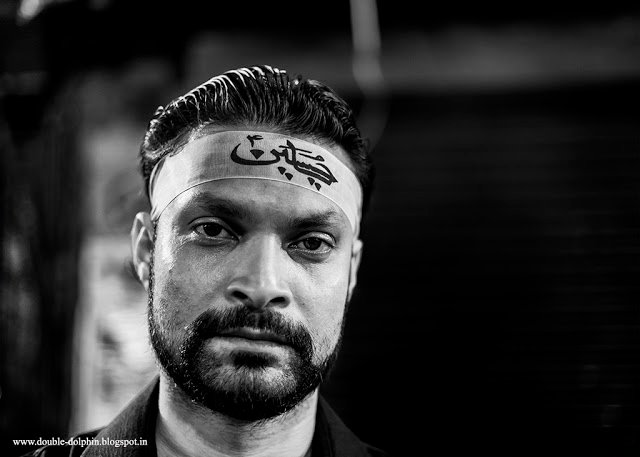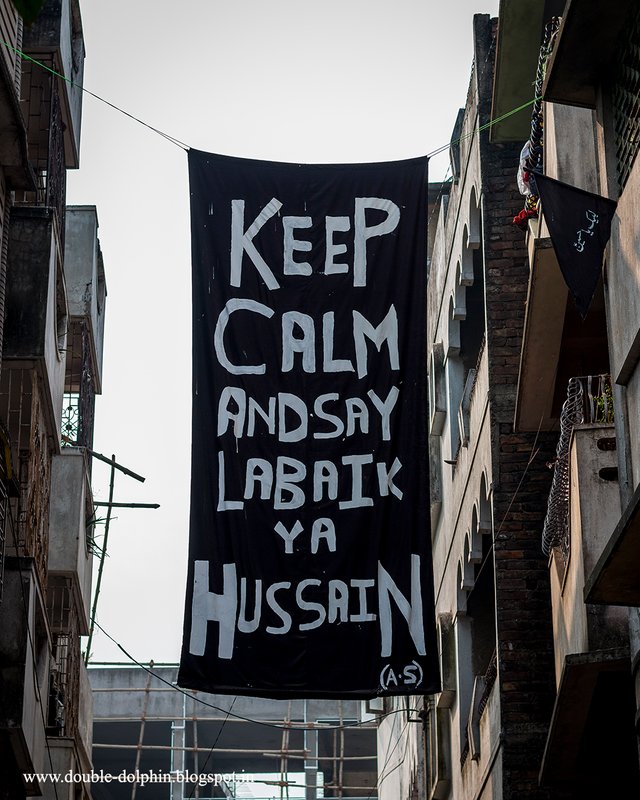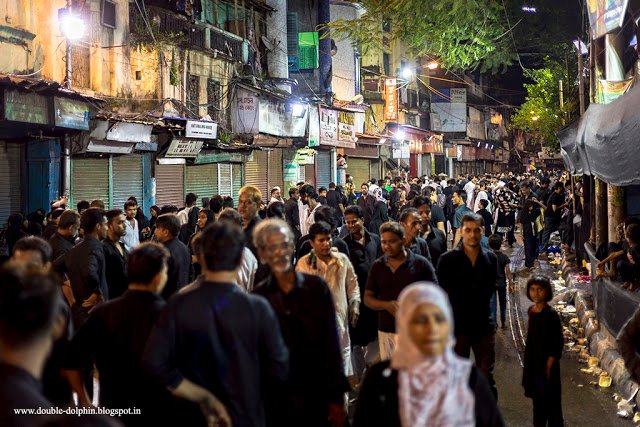Every year as Muharram approaches, Calcutta (Kolkata) radio veteran Mir Afsar Ali must remind his non-Muslim listeners not to wish their Muslim friends a “happy Muharram” because it is not a happy occasion. For most non-Muslims in India, Islamic rituals and practices in general, and Muharram, in particular, remains a complete mystery. People’s reaction to Muharram commemorations is tinged with fear. So this year, I set out to experience and document Muharram commemorations in my hometown, Calcutta (Kolkata).

WHAT IS MUHARRAM?
Muharram is actually a month, the first month of the Islamic calendar and one of the four sacred months of the year. The reason non-Muslims in India know of only one day as Muharram is that that day is an official government holiday and is marked as Muharram in calendars. That day is the 10th day of the month and is known as the day of Ashura. Many historic events have occurred on the day of Ashura. According to well-known preacher Maulana Tariq Jameel, Noah’s ark is said to have landed at Mount Ararat on the 10th of Muharram. Abraham is said to have been delivered from Nimrod’s furnace on the 10th of Muharram. Moses is believed to have split the Red Sea and delivered the Israelites from the tyranny of the Pharaoh on the 10th of Muharram. But what the date is remembered for most of all, are the events that occurred on 61 Al-Hijra. To understand the events of that day, it is necessary to understand a little bit of Islamic history. It is important to stress, before I get into this, that there are a very large number of disagreements about events in Islamic history. There are a large number of sources, which are often contradictory. Added to that is the fact that each school of Islam, Shia, Sunni, and others, have a different set of beliefs. While Sunnis think of Ali as the 4th Caliph, Shias regard him as the 1st. But as a non-Muslim, I shall try and set this out in a manner that makes sense to me and others like me.
After the death of the Prophet Mohammed (PBUH), the question of succession emerged, since none of his sons had survived into adulthood. According to the Hadith of Khumm, the Prophet (PBUH) had proclaimed Ali as his most favourite and the rightful heir in front of an audience. A small group supported Ali’s ascension to the leadership. But his close companion and father-in-law, Abu Bakr was ultimately elected, thus making him the first Caliph or Khalifa, leading the first Caliphate, which can be said to be a kind of Islamic empire. This was the Rashidun Caliphate, Rashidun meaning correctly guided. However, the Rashidun Caliphate was plagued by internal strife, known as Fitna, or the Islamic civil war. The most serious challenge to the Caliphate emerged after Ali, Prophet Mohammed’s (PBUH) son-in-law became Caliph. Ali was technically the 4th Caliph of the Rashidun Caliphate, but the 1st according to Shia belief, since they believe Prophet Mohammed (PBUH) had already nominated him as his successor at the time of his death. The governor of the Levant (modern day Syria), Muawiyah, saw Ali’s failure to take action against the assassins of the previous Caliph, Uthman in June 656 C.E., as evidence of his complicity and went into open rebellion and war. Ali was assassinated on 27th January 661 and was succeeded very briefly by his elder son and Prophet Mohammed’s (PBUH) grandson, Hasan, referred to as Hasan ibn Ali, or Hasan, son of Ali.

Faced with the prospect of further war and bloodshed, Hasan concluded a peace treaty with Muawiyah and abdicated in his favour in 661 C.E., thus laying the foundation of the 2nd Caliphate, called the Umayyad Caliphate, named after Umayya ibn Abd Shams. 9 years later, Hasan died in Medina, believed by some to have been poisoned by one of his wives. And then in 680 C.E., Muawiyah made the decision of nominating his son, Yazid as the Caliph after him. This was a controversial decision for a number of reasons. First, the Caliphate was not supposed to be hereditary. Abu Bakr had established a process of selection via an electoral council or Shura. Second, Muawiyah had specifically agreed to this in his peace treaty with Hasan. Both Hasan and his younger brother Husayn had stayed aloof from politics so far, but this time, matters had come to a head. Husayn refused to swear allegiance to Yazid.
Husayn departed Medina and spent the next 4 months in Mecca. During this period he received multiple letters from the people of Kufa asking him to come and lead them. Kufa, in modern day Iraq, had been an important city even during the early days of the Rashidun Caliphate. The letters from Kufa and the news that Yazid had sent an army to take charge of the Hajj caravans and kill Husayn and his followers, convinced him to travel to Kufa since he did not want the sanctity of the Hajj to be disturbed by a battle. But unbeknownst to Husayn, Yazid had appointed ‘Ubayd Allah ibn Ziyad as the governor of Kufa, who had made the people switch loyalties to Yazid and had his emissary, his cousin Muslim ibn Aqeel, killed. News of Muslim’s killing arrived when Husayn’s party was already on its way to Kufa, and caused most of his followers to abandon him. But a determined Husayn, with a small number of followers (between 70 and 150, 72 being the most commonly agreed upon number), continued towards Kufa and was intercepted 2 days from Kufa, in a place called Karbala, by Yazid’s army, on the 2nd of Muharram, 61 A.H., or 2nd October, 680 C.E..

Yazid’s army would not permit Husayn to return to Medina or proceed to Kufa. Husayn was forced to camp on barren, rocky ground and Yazid’s army denied him access to water, even though they were only a short distance away from the Euphrates river. When Husayn brought out his 6-month-old son, Ali Asghar to plead that he be given water to drink, Yazid’s soldiers shot the child. After more than a week of thirst, the battle finally began on the morning of 10th Muharram, the day of Ashura. With Husayn and his followers numbering 72 and his opponents numbering as many as 30,000 by some accounts, the results were a foregone conclusion. Husayn’s followers were slaughtered, while a heavily injured Husayn was treacherously cut down while saying his final prayers. The women and children in the camp were taken prisoner.
The death of Husayn led to many revolts within the Islamic world and many expressed their regret for their apathy. With Husayn’s death, the Shia-Sunni split in Islam, which began with the controversy of succession, was complete. The word Shia itself is a contraction of the term Shiaat Ali, meaning the partisans of Ali, since it was their belief that Ali, and not Abu Bakr, should have succeeded Prophet Mohammed (PBUH). This battle is what is commemorated now, on the 10th day of Muharram. The phrase “Labbaik Ya Husayn” is commonly used during this commemoration, showing up in posters, t-shirts, headbands, and graffiti and chanted in Muharram gatherings. Labbaik Ya Husayn means “Husayn I am here”, expressing solidarity with him, saying that you are prepared to fight for his cause and expressing regret that you weren’t there in Karbala to stand up for him. While Sunni Muslims also commemorate the day of Ashura through fasting etc, it is an overwhelmingly Shia event. The mourning of Muharram, known as “azadari”, can take several forms. The most benign of them are chanting and beating your chest with your hands. The more extreme forms, called “maatam”, include self-flagellation with chains, blades and even swords. Another aspect of Muharram commemoration is the taking out of Tazia processions. Tazia are miniature faux-mausoleums, imitations of the mausoleums of Karbala, made of coloured paper and bamboo. At the end of the procession, tazias are usually immersed in a water body. There are many such Karbala tanks here in Kolkata. In case such a waterbody is not available, the Tazia is taken to a Karbala ground. From the tank or the ground, the Tazia is taken to the Imambara and preserved for the following year. While it is not uncommon for Sunni Muslims to take out Tazia processions, the biggest Muharram commemorations in Calcutta (Kolkata), happen in areas with large Shia populations, such as Matiyaburj (or Metiabruz), where the Shia arrived with Nawab Wajid Ali Shah, the last Nawab of Oudh.

The first call I received was from my friend Sohail. “The thing that you want to see will happen tonight at Gol Kothi, in Chitpur”. Iftekhar Ahsan of Calcutta Walks lived only a few minutes away from Chitpur and so I gave him a call. “Come down, we’ll go together”, Ifte readily said and so I set off after work to Khairu Place, where he lived and worked. I had been informed that the main event, the “zanjeera maatam”, self-flagellation with knives and chains would happen pretty late in the night, so we tucked into some kebabs from Adam and Dilshad’s Kebab shops in the Phears Lane area before walking down to Chitpur Road, aka Rabindra Sarani.
It was already drizzling when we arrived and the drizzle would continue non-stop through the night, never picking up, but never really stopping. From the crossing at the Faujdari Balakhana till Poddar Court, the Police had barricaded the road. Pedestrians were let through, but cars were turned away. In the middle of this stretch was the Gol Kothi Imambara and when we arrived, people had begun to gather around it. The road was filled with thousands of men and women, mostly wearing black. Many sported white headbands with Husayn’s name written on it in Urdu. There were youngsters with messages about Imam Husayn on their t-shirts. There were families, husbands wives, and very young children. From the ground floor balcony of Gol Kothi Imambara, announcements were being made, asking people to move their parked cars, requesting them to empty certain areas, informing that water was available for those who were thirsty, and so on. Ifte and I walked through the crowd taking photographs as we went. On the pavement, enclosures had been made with bamboo and black cloth were women and young girls were seated. We took our position opposite Gol Kothi, behind a stall that was serving water and waited patiently. The announcements slowly change from the purely operational to the more religious. The leader of the congregation reminded the crowd that they should all be grateful that they are not in Pakistan but in India, where their religious freedoms are protected. In Pakistan, in spite of it being a Muslim country, the Shia are a persecuted minority.
Hi! I am a robot. I just upvoted you! I found similar content that readers might be interested in:
http://double-dolphin.blogspot.com/2017/10/blood-of-faithful-outsiders-experience-muharram-calcutta-kolkata.html
Downvoting a post can decrease pending rewards and make it less visible. Common reasons:
Submit